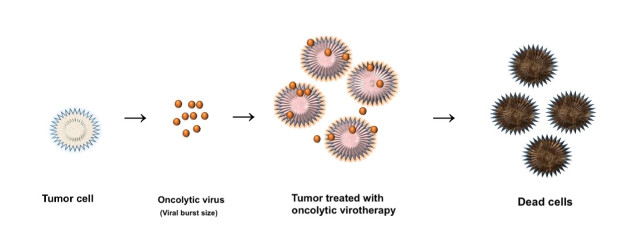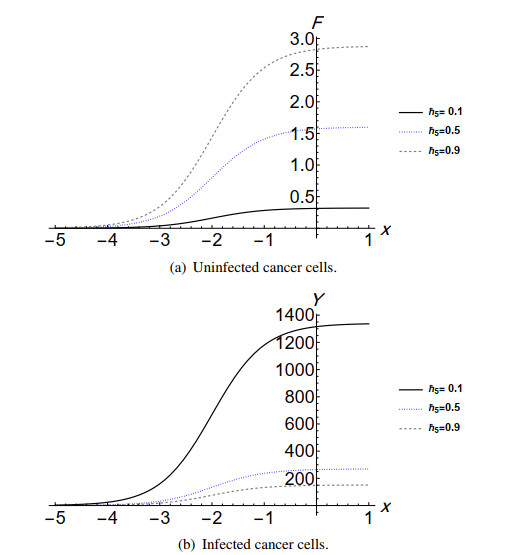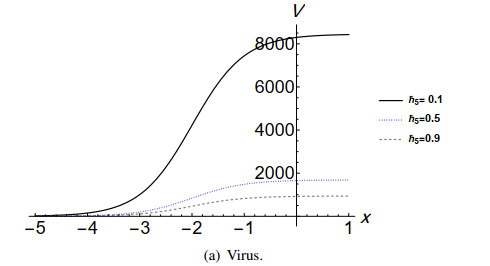1.
Introduction
Recently, cancer therapies have been heavily developed in order to find a therapy that is able to decay the tumor in a short time without harming the neighboring healthy tissue. In the field of genetic engineering, scientists discovered a new cancer treatment by using genetically altered viruses [1]. Oncolytic viruses are genetically altered viruses that infect cancer cells. They grow in an abnormal tumor cell and destroy it without infecting healthy cells or normal tissue. The oncolytic viruses interact with the tumor cell and generate a burst of an oncolytic virus (see Figure 1). The burst size is the number of new viruses resulting from the lysis of an infected tumor cell, and some of the new viruses may infect nearby tumor cells. The burst size is used to measure the replicability of an oncolytic virus [2].
Mathematical models are able to describe biological and medical problems, such as cancer models with a variety of therapies [3,4], epidemic models [5], HIV infection models [6,7,8] and prey-predator models [9]. A few researchers have studied mathematical models of cancer with virotherapy and described the interaction between the virus and the tumor. Wodarz introduced a basic mathematical model that studied tumor growth in the presence of virotherapy treatment [10]. The model has been modified to study the relationship between burst size and virus replicability. The results showed that cancer cells decrease if the burst size is large [11]. On the other hand, some mathematical models have demonstrated the immune system response to virotherapy. Since the immune system treats viruses as foreign bodies and thus destroys them, it shows a negative response to virotherapy that may reduce the quality of viral treatment [12]. Also, many studies describe the interactions between uninfected and infected cells and different kinds of immune responses [13,14].
Herein, we will review the basic model of oncolytic virus replication which was introduced by Wodarz [15]. The model studies the tumor growth and the infection term and it is given by the following system of ordinary differential equations (ODEs):
where f and y are the uninfected and infected cells, respectively, the function X represents the growth of f and y and the function G denotes the rate at which tumor cells become infected by the virus. The coefficients ˉβ and ˉδ are the infection rate of the virus and the death rate of virus-infected cells, respectively, and the coefficient ˉr is the logistical growth rate of uninfected cells. Then, Tian [2] proposed a following common basic model for the virotherapy of three populations:
where v is the free virus population and ˉγ is the death rate of the virus. The coefficient ˉbˉδ refers to the burst size of new viral swarms resulting from killing an infected cell y. The model (2) was also modified in [16] to study the dynamics of oncolytic virotherapy, and it includes four populations, as follows:
where z denotes the innate immune cell population, ˉs is the rate of stimulation of the innate immune cell and ˉp is the rate of immune clearance. Moreover, some models have demonstrated the spread of tumor cells under viral therapy and radiation therapy [17,18].
The immune response and its impact in both uninfected and infected cells were considered in the model (3) in Reference [19] as follows:
where the infected and uninfected cells stimulate the immune response at rates s1 and s2, respectively. The novelty of this paper is its study of the mathematical model in [19] by distinguishing between the naive and activated immune system cells. In addition, we study the spread of viruses and cells by taking a diffusion term into account. Thus, we obtain a system of partial differential equations (PDEs). The immune system cells can be activated by immunotherapy or biological therapy. Therefore, it is very important to distinguish between the naive and activated immune system cells in the mathematical model. Thus, the model introduced in this paper can be useful to study the effects of combining immunotherapy with virotherapy.
The paper is organized as follows. The second section introduces the studied mathematical model, the third section is the theoretical study of the system, the fourth section shows the analytical solutions obtained via the tanh-expansion method, the fifth section discuses the results and the last section is a summary of the work.
2.
Mathematical model
In this section, we reformulate the mathematical model in [19] by considering the five cell populations, which are uninfected cancer cells f, infected cancer cells y, the free virus v, the naive immune cells z and the activated immune cells za, as follows:
where di,i=1,2,3,4,5 denotes the diffusion terms of f,y,v,z and za, respectively. The rest of the parameters are converted to dimensionless parameters in the following system of PDEs and described in Table 1.
The system becomes dimensionless by setting t=τδ, F=Cf, Y=Cy, V=Cv, Z=Cz and Za=Cza and renaming the parameters as follows:
Thus, we obtain the following diffusive PDEs:
Then, the initial conditions become F(0)=f0C, Y(0)=y0C, V(0)=v0C, Z(0)=x0C, Za(0)=xa0C.
3.
Theoretical study
3.1. Positivity and boundedness of the solutions
Theorem 1. Let (F(x,t),Y(x,t),V(x,t),Z(x,t),Za(x,t))=(ˆf(ξ),ˆy(ξ),ˆv(ξ),ˆz(ξ),ˆza(ξ))∈R5+, where ξ=kx+ct+ξ0; then, the solutions (ˆf(ξ),ˆy(ξ),ˆv(ξ),ˆz(ξ),ˆza(ξ)) are nonnegative and bounded in the following region:
where ζ=min{p,μ2}.
Proof. First, we specify the initial value problems for System (6) as follows:
As a result, the solutions are non-decreasing. In order to study the boundedness for the aforementioned system of PDEs, we will transfer the system to a system of ODEs using the traveling wave transformation. Let us define ξ=kx+ct+ξ0; then, we get
From the first equation in System (7), we have
Let us assume the differential equationdF1dt=r1F1(1−F1) with the initial condition F1(0)=F0, which satisfies
hence,
Note that dˆfdt≤dF1dt, which implies that limt→∞supˆf≤limt→∞supF1. Therefore, we have
From the first and second equations in System (7), we have
which satisfy
Again, from the third equation in System (7), we have
which yields
Also, from the fourth and fifth equations in System (7), we note that
where ζ=min{p,μ2}. Thus, we obtain
and
3.2. Equilibrium points
Model (6) has equilibrium points of the form (F,Y,V,Z,Za) such that F≥0,Y≥0,V≥0,Z≥0 and Za≥0. The equilibrium points of the system are the steady-state solutions, which are obtained by setting the following:
However, with help of Mathematica, we obtained five equilibrium points:
where
E2 is positive if b>1+(γ/β), and E3 is positive if p<λz<p+s2.
3.3. Basic reproduction number
The basic reproduction number is the number of cases that are generated by a signal virus in the population [20]. Let P=(Y,F,V,Z,Za), model (7) is rewritten as
where
Next, the Jacobian matrix for υ1(P) and υ2(P) at E1 are computed as follows:
where ρ is the spectral radius. Thus, if R0<1, the cancer will decline; if R0=1, the cancer will stay alive and stable; if R0>1, the cancer will experience growth and outbreak. Therefore, E0 and E1 always exist, E2 exists if R0>1, E3 exists if p+s2>λz>p and E4 exists if R0>1.
3.4. Local stability analysis
We investigate the local stability of the equilibrium points by evaluating the Jacobian matrix of the nonlinear system [21].
Theorem 2. The trivial equilibrium E0 of the system is locally unstable.
Proof. The Jacobian matrix of System (6) at E0 is
It is obvious that the eigenvalues for J(E0) are as follows:
All eigenvalues are negative if r<0. Hence, E0 is locally unstable if r>0.
Theorem 3. The equilibrium point E1 is locally asymptotically stable if only if R0<1.
Proof. By the calculation of the Jacobian matrix at E1, we obtain
The characteristic polynomial is
The eigenvalues of J(E1), which are λ1=−μ2, λ2=−r and λ3=−(p+s2), are negative. By the Routh-Hurwitz criteria, since (β+γ+1) is positive, λ4,5 has a real negative part if b≤1+γβ, which implies that R0<1. Biologically, when the viral burst size b is smaller than the critical value which is 1+γβ, the new produced viruses will be enough to infect tumor cells.
Theorem 4. The equilibrium point E2 is locally asymptotically stable if b>1 and β<r.
Proof. The jacobian matrix J(E2) is
where
The eigenvalues are λ1=−μ2 and λ2=−βs1F3V3−s2F3−p, which are both negative, while λ3,4,5 denotes the zeros of the polynomial λ3+A1λ2+A2λ+A3. It is obvious that A1>0 if b>1, A2>0 if b>1, β<r and R0>1, A3>0 if b>1 and R0>1, and
Therefore, by the Routh-Hurwitz criterion, λ3,4,5 have negative real parts if A1A2−A3>0, which occurs if b>1 and β<r. Thus, E2 is locally asymptotically stable.
Biologically, if the viruses are powerful, which means that the burst size is greater than the critical value, then the system has the equilibrium E2 with the balance of tumor cells, infected tumor cells and viruses.
Theorem 5. The equilibrium point E3 is locally asymptotically stable if b<1, bβ<R0 and R0<1. If λz=0, the point E3 is locally asymptotically stable under the conditions that αβ<κ and bβ<r.
To find the eigenvalue, solve the Jacobian J(E3):
The characteristic polynomial of this matrix is evaluated as follows:
where b0,b1,b2,b3 and b4 are defined in the Appendix. All coefficients are positive if b<1. By using Descartes' rule, the number of sign changes is zero; thus, the point E3 is locally asymptotically stable if b<1.
Theorem 6. The equilibrium point E4 is locally stable if b<1, bβ<r, s1>s2, λz>Z4a and Z4>Z4a.
Proof. To find the Jacobian at the equilibrium point E4, we evaluate |J(E4)−λI|=0, where J(E4) is given by
where E1,1=r(1−Y4−2F4)−αZ4a−βV4−rF4. The characteristic polynomial is
where a0,a1,a2,a3,a4 and a5 are defined in the Appendix. All coefficients are positive if b<1, bβ<r, λz>Z4a, s1>s2 and Z4>Z4a. By using Descartes' rule, the number of sign changes is zero; thus, the point E4 is locally asymptotically stable if b<1, bβ<r, λz>Z4a, s1>s2 and Z4>Z4a.
3.5. Global stability
In this section, the global stability of the equilibrium points will be investigated by using Lyapunov functions [22], which must be positive definite.
Theorem 7. E1 is globally asymptotically stable if 1+b≤r≤2,b≤1.
Proof. The Lyapunov function is defined at point E1 as follows:
The derivative of L1 is
where
The equilibrium equations at E1 are
We found that L′1≤0 if 1+b≤r≤2,b≤1. Hence, E1 is globally asymptotically stable if 1+b≤r≤2,b≤1.
Theorem 8. E2 is globally asymptotically stable if 2<b,r>β R0<1 and 2<Y2<γrbβ.
Proof. The Lyapunov function is defined at E2 as follows:
Thus, we have L′2 as follows:
The equilibrium equations are
Using the equilibrium equations in L′2 gives
where
Note that
and CV=0 if A3=A1b−1. Let A2=A3=A1b−1; then, CFV=−A1β and CF=A1(r(2−Y2)−βV2+βb−1V2). We have that CF<0 if Y2>2. Thus, we obtain CY as
Since Y2>2, CY<0. Thus, CZa becomes
If A5=A1μ2(b−1)(αfγβ+κV2+μ1Y2) and we let A4=A1, we obtain C∗ as follows:
We get that L′2≤0 if 2<Y2<γrbβ. Hence, E2 is globally asymptotically stable.
Theorem 9. E3 is globally asymptotically stable if b<1; then, p<λ<p(μ2r+αfs2Z3)μ2r+αfs2, γ(r+αfs1Z3μ2)1−b<β, and r>2λzαfμ2.
Proof. The Lyapunov function at E3 is defined as follows:
and its derivative is
After substituting the points F3,Z3 and Za3 in L′3, we get
where
The equilibrium equations at (F3,0,0,Z3,Za3) are
If A4=A5, then BFZ=0 and BYZ=0. If A3=A2, then BFV<0, A3=A1βF3γ and BV=0. If A5=A1F3αfμ2, then BZa=0. Thus,
and since b<1, we have that γ(r+αfs1Z3μ2)1−b<β and
and
L′2≤0 if r>2λzαfμ2. Hence, E3 is globally asymptotically stable.
4.
Analytical solution
Finding the solutions of the system helps to understand the dynamics of the solutions. Some researchers have found numerical solutions for biological systems by using Galerkin meshless method [23] or traveling wave solutions [24]. Since there are no initial conditions available, the best way is to apply an analytical method which does not require initial or boundary conditions. We shall the use tanh-expansion method to find the solutions [25]. The following are the steps to construct the solution:
(1) Transfer the system of PDEs given by (6) into the system ODEs given by (7) using a traveling wave transformation, which is defined by ξ=kx+ct+ξ0.
(2) Assume that
and substituting (14) into the equation of System (7) gives a polynomial of u and its derivatives:
(3) Assume that
where M is a positive integer and
where μ and ai are constants such that
(4) Apply the homogeneous balance theorem to find the value of M, i.e., balance the linear terms of highest order in the previous equation with the highest-order nonlinear terms.
(5) Substitute Eq (16) into the equations of System (15) to obtain an equation of Φi.
(6) Equate the confections of Φi to zero to obtain the ai's and η's. By following Steps (1) and (2), we obtain the following system of equations:
Then, we sum all of the equations to obtain a single equation, as follows:
where
Next, we follow Steps (3) and (4) and balance between the nonlinear term u2 and the highest order of the derivative u′′; we get 2M=4+M−2, which satisfies M=2. Thus,
Substituting Eq (20) into ODE (19) gives
Note that
Substituting Eq (22) into Eq (21) and collecting all of the terms with the same power of Φ together implies the following:
this can be rewritten as
Then, we equate the constant bi's to zero to obtain the algebraic system of equations and find the ai's and η's.
Thus, the solutions are in the following form:
where
and
5.
Discussion of results
The presented mathematical model aims to elucidate the effects of combining viral therapy with the immune response and its spread. First, we ignored the diffusion terms and solved the problem by using the Runge-Kutta 4th-order method using the values of the non-dimensionless parameters according to Reference [16], as follows:
We considered two cases: (a) μ1=μ2=0.2,s1=0.2,s2=0.6 and (b) μ1=μ2=0.7s1=0.2,s2=0.6, where the initial conditions are F=0.9,Y=0.5,V=0.5,Z=0.1 and Za=0.2.
The results in Figure 2 show that, in Case (a), the unaffected cells F decreases during the treatment when the concentration of activated immune system cells is low. On the other hand, the high concentration of Za helps to maintain the level of healthy cells in the body. Therefore, we predict that the combination of biological therapy and virotherapy reduces the side effects of the virotherapy, and the patient's body may become less weak during the treatment.
The immune response against cancer cells has been investigated for decades. It has been determined that the immune system actively patrols the body [26]. From this standpoint, we investigate the diffusion coefficient of the immune system d5. The solutions of Model (6) are found by employing the tanh-expansion method to study the effect of the treatment on cancer growth. The solution is presented in Eq (24), which indicates that d5 is dependent on d1,d2,d3 and d4. The diffusion of activated immune system cells (d5) increases when the diffusion of the unaffected cells (d1) or naive immune system cells (d4) increases, while it decreases by increasing the diffusion of the virus (d2) or infected cells (d3).
Note that η5 is another parameter that affects the solution, as we can see in Figures 3–5. The parameter η5 is a coefficient that is associated with Za. When η5 increases, the concentrations of uninfected cells F and activated immune system cells Za increase, while the concentrations of infected cells y, virus v and naive immune system cells Z decrease. We observed that the immune cells Z have the highest concentrations compared to other components in the system, and this indicates the response of the immune system for viral treatment. {However, the immunotherapy has been widely used in different protocols to treat cancers [27]. We predict good results of the combination between immune therapy and virotherapy. The results are aligned with the clinical trial in Reference [28]. This clinical trial confirms the possibility of combining the immunotherapy and virotherapy.
6.
Conclusions
In this work, we modified a mathematical model of cancer and virotherapy to study the dynamics of virotherapy with tumor cells and the effects of the immune response. In addition, this modification distinguishes between two types of immune system cells, which are the activated cells and naive cells. The results predict that the high concentration of activated immune cells leads to enhanced results of virotherapy. The activated immune cells can be generated in the patient's body through biological therapy. Moreover, the model was analyzed by using the stability theory of nonlinear systems. We studied the stability of five equilibrium points and determined the conditions of the existence and local and global stability of the equilibrium points. As a result, the success of viral treatment depends on the size of the burst b, the viral infection rate β and the clearance rate of viruses γ, which depend on the type of the virus. The treatment by virotherapy can be more effective by stimulating the activated immune cells. Furthermore, we found the analytical solutions for the studied model by using the tanh-expansion method because of a lack of initial and boundary conditions. We found that, if the concentration of activated immune cells Za increases, the unaffected cells f increase, which indicates the improvement of the treatment results.
However, for future work, the studied model can be solved numerically by finding the associated initial and boundary conditions based on real data, and by using the Galerkin method [23]. Also, diffusion terms can be added in many biological models to study the spread of the model components and deal with a system of PDEs.
Conflicts of interest
The authors declare that there is no conflict of interest regarding the publication of this paper.
Appendix
The definitions of b0,b1,b2,b3 and b4 that are related to the characteristic polynomial for E2 are as follows:
The definitions of a0,a1,a2,a3,a4 and a5 that are related to the characteristic polynomial for E4 are as follows:










 DownLoad:
DownLoad:







